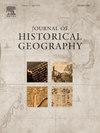A historical geography of surveying: Inoh Tadataka's East and Central Japan cartographic expeditions (1800–1803)
IF 1.1
2区 历史学
Q2 GEOGRAPHY
引用次数: 0
Abstract
This study examines the historical surveying of Inoh Tadataka in early modern Japan by focusing on surveying operations. Using Geographic Information Systems (GIS) in combination with Inoh's diaries, we assess how geographical and institutional factors influenced surveying distances and durations. This was analysed in relation to topography, slope, weather and resources available through government support. The results show that the average daily surveying distance and time were longest in the early expeditions that followed a favourable inland route with limited governmental support. By contrast, the daily averages were shorter in the later expeditions with increased government support, partly due to more challenging terrain. This suggests that increased governmental support was insufficient to offset the growing geographical challenges. Our research emphasizes how historical cartography is embedded in spatial and socio-political contexts. GIS has enabled us to better understand the mechanisms by which surveying practices adapt to both geospatial constraints and socio-political frameworks. This study demonstrates the potential of the GIS approach for interpreting the cartographic dynamics in the early modern period.
测量的历史地理学:Inoh Tadataka的日本东部和中部地图探险(1800-1803)
本研究以测量操作为重点,考察了近代早期日本田孝的历史测量。利用地理信息系统(GIS)结合Inoh的日记,我们评估了地理和制度因素如何影响测量距离和持续时间。这与地形、坡度、天气和政府支持的资源有关。结果表明,在政府支持有限的情况下,沿着有利的内陆路线进行的早期探险,平均每天的测量距离和时间最长。相比之下,在政府支持力度加大的后期探险中,日平均距离变短了,部分原因是地形更具挑战性。这表明增加政府支助不足以抵消日益增加的地理挑战。我们的研究强调历史制图是如何嵌入在空间和社会政治背景。地理信息系统使我们能够更好地理解测量实践适应地理空间限制和社会政治框架的机制。本研究证明了GIS方法在解释近代早期制图动态方面的潜力。
本文章由计算机程序翻译,如有差异,请以英文原文为准。
求助全文
约1分钟内获得全文
求助全文
来源期刊

Journal of Historical Geography
Multiple-
CiteScore
1.50
自引率
10.00%
发文量
53
期刊介绍:
A well-established international quarterly, the Journal of Historical Geography publishes articles on all aspects of historical geography and cognate fields, including environmental history. As well as publishing original research papers of interest to a wide international and interdisciplinary readership, the journal encourages lively discussion of methodological and conceptual issues and debates over new challenges facing researchers in the field. Each issue includes a substantial book review section.
 求助内容:
求助内容: 应助结果提醒方式:
应助结果提醒方式:


